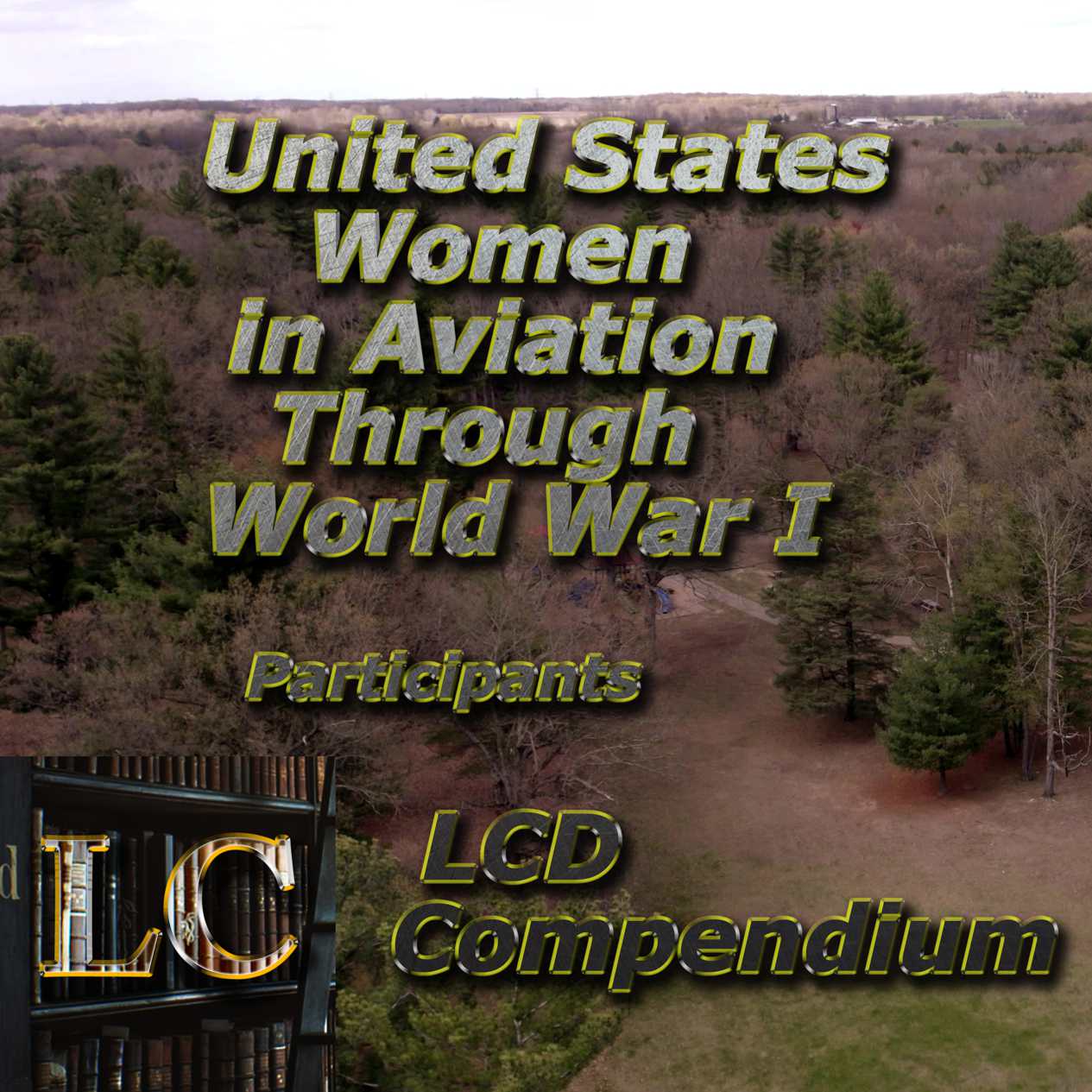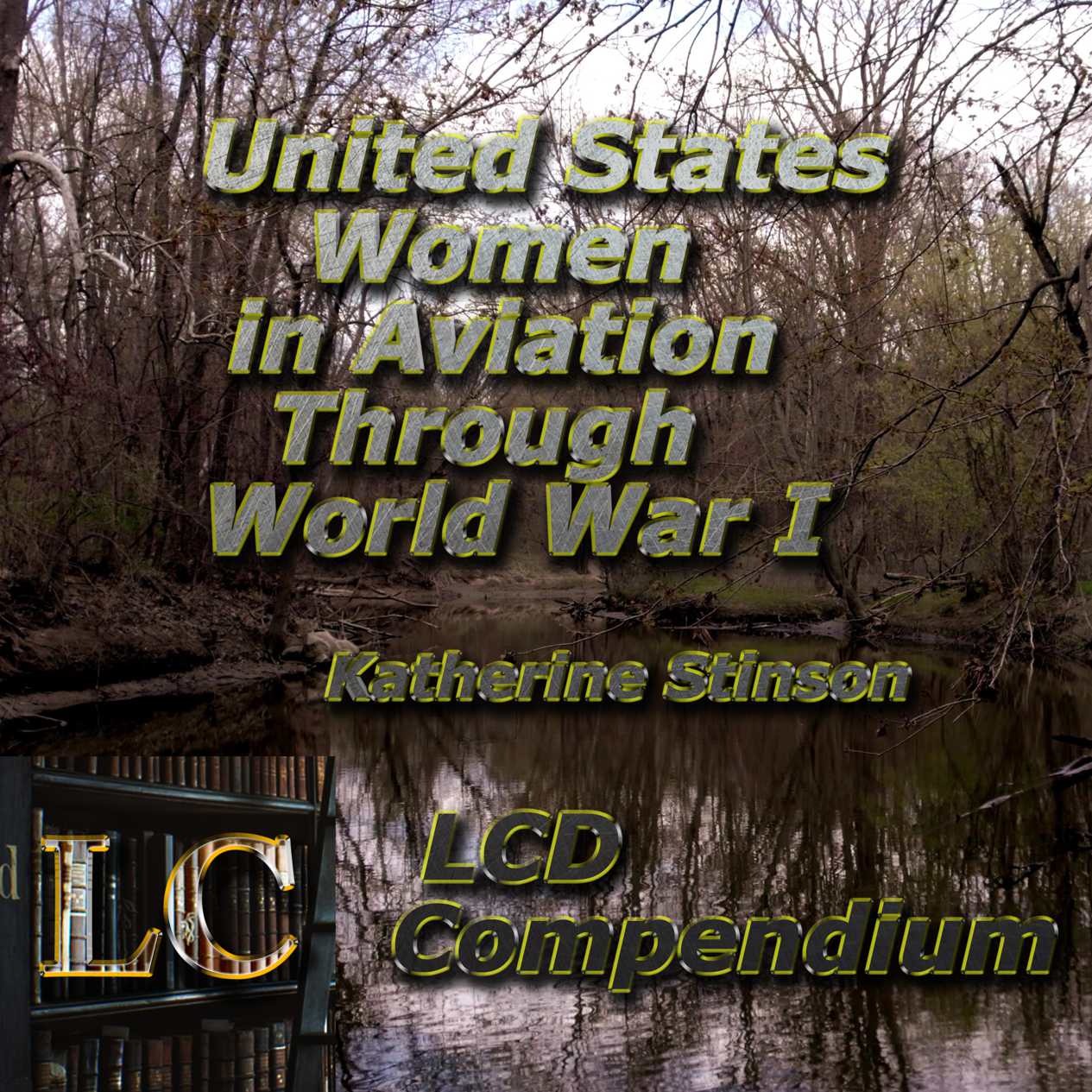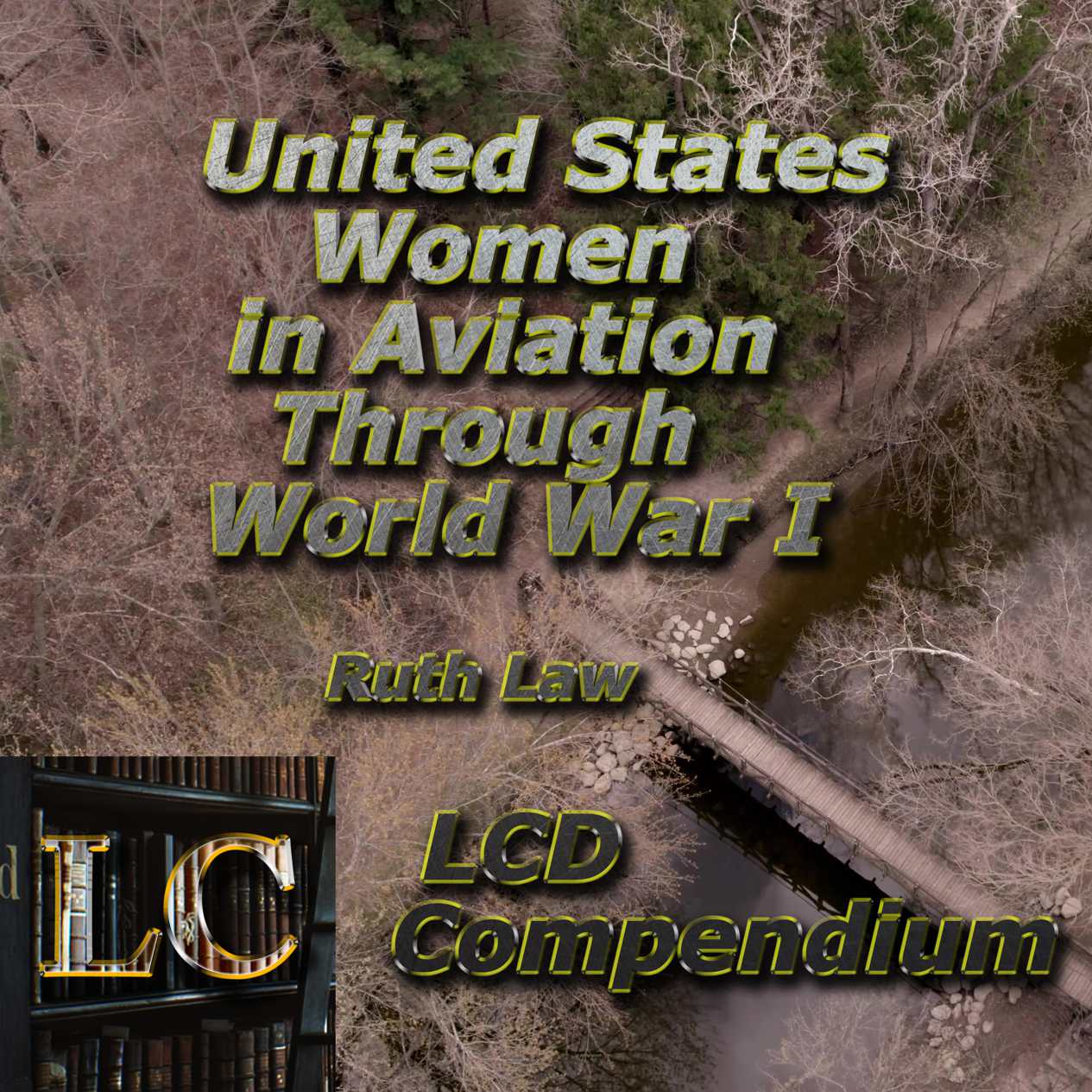Episode Transcript
1
0:00:00,000 --> 0:00:04,000
SERIES PUBLICATIONS OF THE. SMITHSONIAN INSTITUTION
2
0:00:04,000 --> 0:00:08,000
SMITHSONIAN STUDIES IN AIR AND SPACE NUMBER 2
3
0:00:08,000 --> 0:00:13,000
United States Women in Aviation through World War One
4
0:00:13,000 --> 0:00:15,000
by Claudia M Oakes
5
0:00:15,000 --> 0:00:27,000
Aerial Photography from Photations Visit Photations.com and www.PhotationsStore.com for more fine art photography
6
0:00:27,000 --> 0:00:32,000
Help support this series by visiting PhotationsDonations.com
7
0:00:32,000 --> 0:00:34,000
Participants
8
0:00:34,000 --> 0:00:42,000
The woman credited with being the first in the United States to pilot her own aircraft was Mary H
9
0:00:42,000 --> 0:00:55,000
Myers of Mohawk, New York Billed as 'Carlotta, the Lady Aeronaut,' she made her first solo balloon flight on 4 July 1880, at Little Falls, New York
10
0:00:55,000 --> 0:00:57,000
Her husband, Carl E
11
0:00:57,000 --> 0:01:20,000
Myers, influenced by the work being done in Europe, had for several years been experimenting with air navigation, especially ballooning He worked on making a portable, efficient hydrogen generator and on designing a balloon basket that would be lighter than the wicker ones then in use
12
0:01:20,000 --> 0:01:44,000
His greatest contribution, however, was in the development of a new balloon fabric By dipping cotton fabric into a specially prepared linseed oil mixture, he arrived at a durable, nonporous product that was so flexible it would not crack when folded and that would last as long as ten years, surviving many rough landings
13
0:01:44,000 --> 0:02:08,000
Mary Myers assisted her husband in his research and then became so interested in the work that she began piloting balloons herself No one knows the origin of her professional name 'Carlotta,' but it was certainly more attention getting than 'Mary' and also identified her with her husband Carl
14
0:02:08,000 --> 0:02:20,000
Carlotta’s fame soon spread throughout the northeast and she was frequently hired during the season at Saratoga Springs to make ascensions there
15
0:02:20,000 --> 0:02:43,000
Her proficiency rapidly increased, until she could tell her carriage driver exactly where she would land so that he could be waiting for her Her ability to do this was aided by the hammock netting car her husband had developed which was much more maneuverable than the wicker type
16
0:02:43,000 --> 0:02:56,000
The flat bottom of cross laid veneered wood acted as a steering mechanism it descended in the line of its lowest edge when Carlotta stepped to the side she wished to approach
17
0:02:56,000 --> 0:03:03,000
Carlotta cool headedly came out safely from many dangerous situations and near accidents
18
0:03:03,000 --> 0:03:26,000
But the most frightening occurred at Syracuse when she was accompanied by her seven year old daughter Bessie Lacking ballast because of the presence of the little girl, the balloon descended too quickly into a steep sided lake, and overhanging trees prevented Carlotta from bringing it down close to shore
19
0:03:26,000 --> 0:03:38,000
Bessie saved the day by crawling out onto a half submerged log and pulling the balloon to shore with the rope Bessie never again made a balloon ascension
20
0:03:38,000 --> 0:03:50,000
At the 1903 St Louis Exposition, however, she gave an indoor demonstration of a foot pedalled dirigible designed by her father
21
0:03:50,000 --> 0:04:04,000
In 1886 at Franklin, Pennsylvania, Carlotta established a new world altitude record of four miles, in a balloon filled with natural gas instead of hydrogen
22
0:04:04,000 --> 0:04:15,000
As notable as the record itself, however, is the fact that she ascended to this height without benefit of oxygen equipment
23
0:04:15,000 --> 0:04:34,000
Carl’s aviation interests had vastly increased, and in 1889 he bought a large Victorian mansion in Frankfort, New York Here he set up his 'Balloon Farm' where he stored, built, and cataloged his balloons
24
0:04:34,000 --> 0:04:44,000
Carlotta supervised the running of the house and the business, continuing to make ascensions but only on special occasions
25
0:04:44,000 --> 0:05:10,000
One of these flights was from the Washington Park baseball field in Brooklyn, over Brooklyn City Hall, to the Battery, turning upriver to the Brooklyn Bridge, then over New York City Hall, and on to Jersey City She did this during New York’s rush hour, and many people cheered at the sight of her precision flying
26
0:05:10,000 --> 0:05:21,000
Because of her increasing responsibilities at the 'Balloon Farm,' Carlotta retired from public exhibition work in 1891
27
0:05:21,000 --> 0:05:29,000
She did continue to test fly balloons at the 'Farm' which continued operation until about 1910
28
0:05:29,000 --> 0:05:37,000
Probably the first woman to invent her own aircraft was Miss. E Lillian Todd of New York City
29
0:05:37,000 --> 0:05:51,000
In December 1906 she brought to the exhibition of the Aero Club of America an airship and an airplane that she had designed and built herself
30
0:05:51,000 --> 0:05:58,000
The airplane was unique in construction, being really more of a glider, since it had no engine
31
0:05:58,000 --> 0:06:13,000
The pilot would take a running start along an inclined plane, causing the fans to revolve and catch the air This would activate the two propellers, and the aircraft would, theoretically, lift off
32
0:06:13,000 --> 0:06:31,000
To land, the pilot opened a valve which reduced the amount of air to the fans, causing the propellers to slow their revolutions, and the aircraft would gradually settle to earth, pneumatic wheels cushioning the impact
33
0:06:31,000 --> 0:06:44,000
Miss. Todd had begun designing and building mechanical objects as a child With no training at all in the use of tools, she taught herself by trial and error
34
0:06:44,000 --> 0:06:53,000
Her decision to build an airship came early in her life She had bought a wind up toy which was supposed to soar through the air
35
0:06:53,000 --> 0:07:09,000
It performed so poorly that she considered it an insult to her intelligence, feeling she herself could build a better one She did design and build a model dirigible, which flew successfully
36
0:07:09,000 --> 0:07:21,000
For a few years she put aside her work on aircraft, but Alberto Santos Dumont’s successes with airships inspired here to resume
37
0:07:21,000 --> 0:07:42,000
Several leading figures of the time, including Andrew Carnegie, expressed interest in Miss. Todd’s inventions But although several contemporary newspapers carried accounts of the machines being exhibited, no mention has been found as to whether they were ever test flown
38
0:07:42,000 --> 0:07:50,000
Other women during the early part of the twentieth century were involved with flying lighter than air craft
39
0:07:50,000 --> 0:08:07,000
Gen. eve Shaffer of San Francisco was piloting free balloons in 1909 and 1910 During one of her ascensions she made the first aerial photographs of Oakland and San Francisco
40
0:08:07,000 --> 0:08:30,000
In the fall of 1909 Gen. eve was co pilot in the balloon 'The Pride of San Francisco' flown by the famous balloonist Ivy Baldwin During that year’s Portola Festival, their balloon engaged in a race across San Francisco Bay with another balloon, 'The Pride of Oakland,' piloted by Capt. Van Tassel
41
0:08:30,000 --> 0:08:46,000
During the first race the wind failed and both balloons were forced down on mud flats on what is now the Alameda Naval Air Station To satisfy the people who had wagered on the race, the balloons ascended again
42
0:08:46,000 --> 0:08:54,000
They reached the mainland almost simultaneously but with 'The Pride of San Francisco' ahead by enough to win
43
0:08:54,000 --> 0:09:09,000
Gen. eve is also credited with being the first woman glider pilot in the United States She made her first solo flight on 1 August 1909, in a glider built by her brother Cleve
44
0:09:09,000 --> 0:09:19,000
She also worked with Cleve in his Shaffer Aero Manufacturing Co , serving as secretary and chief rigger
45
0:09:19,000 --> 0:09:42,000
Gen. eve’s glider flights were such sensations that to keep from being constantly annoyed by the press, Cleve had two signs made with letters four inches tall, one of which he would hang in front of their house each day to proclaim either: SHE. WILL FLY TODAY or SHE. WILL NOT FLY TODAY
46
0:09:42,000 --> 0:09:53,000
Perhaps the most unusual flight by a woman in those early days of aviation occurred at St Louis in November 1910
47
0:09:53,000 --> 0:10:08,000
Helene Mallard became the first woman in the world to ascend by means of a kite Ms. Mallard sat in a swinglike contraption attached to twelve large 'aeroplane kites' designed by Samuel F
48
0:10:08,000 --> 0:10:16,000
Perkins of Dorcester, Massachusetts The kites raised Ms. Mallard to a height of forty feet
49
0:10:16,000 --> 0:10:22,000
Another route to fame for women in the field of aviation was parachuting
50
0:10:22,000 --> 0:10:41,000
Georgia 'Tiny' Broadwick was the first woman in the world to make a parachute jump from an airplane She performed this historic feat on 21 June 1913, to demonstrate the effectiveness of a new parachute designed by Glenn L
51
0:10:41,000 --> 0:10:57,000
Martin Martin himself was pilot of the aircraft that, traveling at about 30 miles per hour ground speed, carried Tiny to a height of approximately 1000 feet above Griffith Park aviation field in Los Angeles
52
0:10:57,000 --> 0:11:11,000
Tiny was seated on a small platform attached to the right wing of the aircraft When she was ready to drop, she released a lever that collapsed the seat and allowed her to fall straight down
53
0:11:11,000 --> 0:11:16,000
Her parachute opened perfectly, and she even landed on her feet
54
0:11:16,000 --> 0:11:38,000
Tiny by that time was a veteran of many parachute jumps from balloons She had become interested in aviation in 1908 when she saw Charles Broadwick’s exhibition of ballooning and decided this was something that she, too, wanted to do
55
0:11:38,000 --> 0:11:48,000
Her mother gave her permission, and Tiny joined Broadwick’s group, taking his surname as did the other members of the group
56
0:11:48,000 --> 0:11:56,000
Broadwick, himself a parachutist, constructed his own balloons and parachutes
57
0:11:56,000 --> 0:12:20,000
He first taught Tiny to parachute from balloons (she was later to say that jumping from airplanes was far easier than jumping from balloons) Her agreement with Broadwick called for her to make six jumps a week for dollar in the amount of 250, with dollar in the amount of 25 added for each additional jump
58
0:12:20,000 --> 0:12:36,000
She would sometimes jump with more than one chute, cutting them loose in succession as she descended These multiple chutes were usually red, white, and blue, a beautiful spectacle in the air
59
0:12:36,000 --> 0:12:44,000
She also jumped at night with flares extended about two feet from either side of her body
60
0:12:44,000 --> 0:12:51,000
Tiny was also the first person to demonstrate a parachute for U S
61
0:12:51,000 --> 0:13:00,000
Government officials This occurred at North Island, San Diego, in the summer of 1915
62
0:13:00,000 --> 0:13:23,000
Using a parachute that was one of Charles Broadwick’s own designs, Tiny jumped at a height of 1500 feet from a Curtiss aircraft moving at about 75 miles per hour and piloted by Wright instructor Oscar Brindley She dived head downward, the parachute opened readily, and Gen. George P
63
0:13:23,000 --> 0:13:26,000
Scriven, chief of the U S
64
0:13:26,000 --> 0:13:30,000
Army’s aviation bureau, was greatly impressed
65
0:13:30,000 --> 0:13:49,000
Tiny never got her pilot’s license, although Glenn Martin allowed her to fly certain of his aircraft in a limited area She married a sea captain in late 1915 and after that made only occasional jumps
66
0:13:49,000 --> 0:14:01,000
After having made more than 900 jumps, she retired completely in 1922 because she felt the novelty had worn off for the public
67
0:14:01,000 --> 0:14:16,000
Hilder Smith, another parachutist, also worked with Glenn Martin Hilder and her husband, Floyd, met in 1906 when he was a circus trapeze artist
68
0:14:16,000 --> 0:14:40,000
In 1911, as the excitement of the new field of aviation was becoming contagious, Floyd decided to build and fly his own airplane, although neither he nor Hilder had had any aeronautical experience They began construction in January 1912 with Hilder shaping the wing ribs and applying the fabric
69
0:14:40,000 --> 0:14:56,000
In June the plane was finished, and Floyd installed dual controls so that Hilder could learn to fly with him The Smiths’ first barnstorming tour, however, turned out to be their last: they were grounded by creditors
70
0:14:56,000 --> 0:15:03,000
Floyd went to work for Glenn Martin as a mechanic and then as Martin’s chief test pilot
71
0:15:03,000 --> 0:15:19,000
It was while he was making a test flight for Martin that he began his work on developing the manually operated free parachute which was used worldwide for many years by civilian and military pilots alike
72
0:15:19,000 --> 0:15:32,000
Martin had scheduled a combination exhibition flight and parachute jump in 1914 as part of the ceremonies opening Los Angeles’ inner harbor
73
0:15:32,000 --> 0:15:49,000
Hilder Smith, who had worked with her husband in his parachute experiments, agreed to perform in the parachute portion in exchange for flight instruction and use of Martin aircraft
74
0:15:49,000 --> 0:16:11,000
Hilder made her jump from about 600 feet, but as she left the aircraft she twisted and fouled her chute, which streamed along behind her She had a free fall of about 400 feet, working frantically all the while (with the aid of her trapeze training) to untangle the lines
75
0:16:11,000 --> 0:16:23,000
The chute opened about 200 feet above the water, and by swinging her feet to control her course she avoided the masts of the boats below her and reached land safely
76
0:16:23,000 --> 0:16:34,000
That was Hilder’s last jump, but she continued flying aircraft at Glenn Martin’s school where Floyd was instructing pilots for World War One
77
0:16:34,000 --> 0:16:42,000
She also flew as her husband’s observer when he was testing new types of aircraft
78
0:16:42,000 --> 0:16:55,000
When Gen. Scriven congratulated Tiny Broadwick on her fine demonstration of parachuting, he told her she was a 'plucky girl ' She replied, 'I don’t call it pluck
79
0:16:55,000 --> 0:17:07,000
I call it joy' (author unknown, 1915) It was for the joy of being free and soaring through the air that these women made their balloon flights and parachute jumps
80
0:17:07,000 --> 0:17:13,000
Women were soon to find joy and freedom in piloting their own airplanes, too



